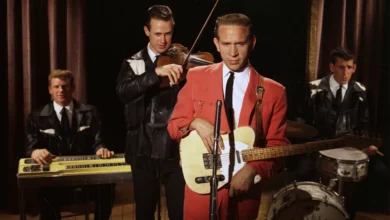Brenda Lee’s “I’m Sorry” Redefines Teen Pop Balladry in 1960
In 1960, Brenda Lee released “I’m Sorry,” a heartfelt ballad that would not only top the Billboard Hot 100 but also redefine the concept of a teen pop ballad. At just 15 years old, Lee delivered a performance that belied her youth, captivating audiences with a voice brimming with maturity and emotion. The song quickly rose to number one, demonstrating a crossover appeal that transcended traditional pop boundaries and solidifying Brenda Lee’s status as a major force in the music industry.
Born Brenda Mae Tarpley in Atlanta, Georgia, Lee was drawn to music from an early age, performing in talent shows and local radio stations before she could even attend school full-time. Her powerful voice earned her the nickname “Little Miss Dynamite,” a testament to her ability to belt out songs with an intensity that far exceeded her small stature. By her early teens, she had already scored a few moderate hits, but it was “I’m Sorry” that truly put her on the map and showcased the depth of her vocal abilities.
The story behind “I’m Sorry” began with songwriters Dub Allbritten and Ronnie Self, who had collaborated on several other pieces. Legend has it that the song’s raw, vulnerable lyrics were inspired by a friend’s romantic regrets, lending an air of authenticity to the ballad. When Lee first heard it, she was immediately drawn to its emotional core, convinced that her own heartfelt delivery could bring the story to life. The track was initially considered a risky choice for a teenage singer, but Lee insisted on recording it, confident that her vocal style would resonate with audiences.
Recorded at the famous Bradley Film & Recording Studios in Nashville, “I’m Sorry” featured lush string arrangements and a gentle rhythm section that highlighted Lee’s powerful voice. The production was overseen by Owen Bradley, a producer well-known for his role in shaping the “Nashville Sound,” which blended traditional country elements with pop sensibilities. The balance of orchestrations and subtle background vocals allowed the full weight of Lee’s emotional performance to shine through, marking a turning point in how teenage singers were perceived by the music industry.
Upon its release, “I’m Sorry” quickly gained traction on radio playlists across the country. It soared to the top of the Billboard Hot 100, where it spent three weeks at number one. The song also enjoyed crossover success on the country charts, reflecting its broad appeal. Critics praised Lee’s vocal prowess, noting that she could deliver both the innocence of youth and the wisdom of heartbreak in a single phrase. Before long, the track became an anthem for teenage listeners grappling with the pains of young love.
Culturally, “I’m Sorry” had a profound impact on the pop landscape. At a time when rock and roll was dominated by male artists and the airwaves were filled with upbeat dance numbers, Lee’s tender ballad brought a welcome change of pace. Her ability to convey deep emotion at such a young age challenged assumptions about teenage singers, paving the way for future young artists to tackle serious, introspective material. The song’s blend of pop and country elements also blurred genre lines, appealing to a wider audience than many of her contemporaries.
For Brenda Lee herself, the success of “I’m Sorry” opened up a world of new opportunities. She embarked on extensive tours, both in the United States and internationally, where her diminutive stature and mighty voice made her a sought-after performer. As the single continued to climb the charts, she found herself in high demand for television appearances, including variety shows and music specials that showcased her vocal range. This newfound fame also led to collaborations with other leading artists and producers of the era.
Beyond its immediate commercial triumph, “I’m Sorry” influenced the direction of popular music, particularly for female vocalists. It served as a blueprint for the teen pop ballad, inspiring numerous artists to explore more emotive and mature themes in their work. Singers like Connie Francis and Skeeter Davis would later follow in Lee’s footsteps, recording their own dramatic ballads that resonated with audiences far beyond the teenage demographic.
Over the years, “I’m Sorry” has been covered by a variety of artists. Notable renditions include those by country singer Debbie Gibson and even rock-oriented performers who appreciated the song’s timeless emotional resonance. Each cover brought its own flavor, but few could match the raw vulnerability of Lee’s original performance. To many listeners, her version remains definitive, a testament to the unique blend of youth and emotional depth she brought to the track.
At the time of the song’s release, Lee was also navigating personal challenges. Growing up in the public eye, she faced the pressures of balancing a demanding performance schedule with the everyday experiences of a teenager. Yet, the success of “I’m Sorry” only strengthened her resolve, providing her with the confidence to pursue more ambitious projects. As her fame grew, she maintained a close-knit relationship with her family, who had supported her passion for singing since her earliest days.
Decades later, “I’m Sorry” remains a fixture on oldies radio and is frequently listed among the greatest pop ballads of all time. The track’s timeless quality ensures that new generations continue to discover it, often marveling at how a 15-year-old could deliver such a nuanced and affecting performance. Its frequent inclusion in compilations and greatest-hits albums highlights its enduring relevance in popular music history.
In retrospect, the song’s production techniques—especially the seamless fusion of country and pop elements—were ahead of their time. Lee’s heartfelt approach to singing foreshadowed the emotive style that would later dominate in adult contemporary music. By bridging the gap between youthful innocence and the weight of romantic regret, “I’m Sorry” played a key role in shaping how future ballads were composed and recorded.
Though Brenda Lee’s career would continue to flourish, “I’m Sorry” remains one of her crowning achievements. The track received numerous accolades and recognition, with Lee eventually earning spots in both the Country Music Hall of Fame and the Rock and Roll Hall of Fame. This dual honor reflects the genre-defying nature of her work, and “I’m Sorry” stands as a prime example of her ability to cross boundaries and connect with audiences worldwide.
Ultimately, “I’m Sorry” endures because it speaks to universal themes of love and regret in a way that feels both deeply personal and broadly relatable. Brenda Lee’s vocal performance stands as a testament to the power of raw talent combined with impeccable production. Even in an era dominated by rock and roll and shifting cultural tides, she carved out a space for earnest emotional storytelling that has stood the test of time. Few songs capture the spirit of heartbreak and youthful longing as effectively, ensuring “I’m Sorry” a lasting place in the pantheon of pop classics.



